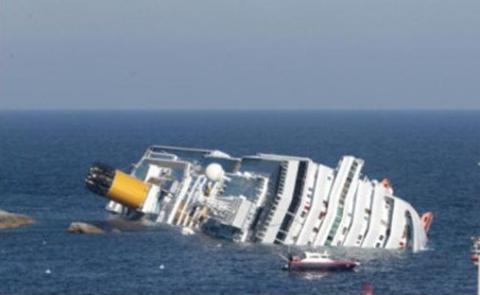Submitted by World Revolution on
At the time of writing 17 bodies have been found and as many as 20 passengers are still unaccounted for following the shipwreck of the Costa Concordia off the Italian island of Giglo on 14th January.
The captain of the ship became the immediate target of blame after denying that he had rushed to get off before the passengers and was only in a lifeboat because he ‘fallen’ into it and was simply unable to get back on board as he wanted to. He also claimed the rocks he steered the ship onto and which ripped its hull open were not on his map. Reports followed that he might have been drinking or was showing off, possibly to a mystery woman, and that he had delayed getting the passengers off for an hour.
Costa Cruises, which operates a large number of similar ships and whose parent company, Carnival Corporation, owns 10 cruise providers, was quick to join in. The day after the incident, after noting that “the investigation is ongoing”, the company was nonetheless able to conclude “preliminary indications are that there may have been significant human error on the part of the ship’s Master, Captain Francesco Schettino, which resulted in these grave consequences. The route of the vessel appears to have been too close to the shore, and the Captain’s judgement in handling the emergency appears to have not followed standard Costa procedures.”
Whatever blame the Captain may or may not deserve, it is clear that there are wider issues. Concerns had already been raised about the design of the current generation of cruise ships[1] by Nautilus International, a maritime trade union, with safety being compromised for commercial reasons. For example, shallow draughts allow passengers to board easily, but can cause stability problems in certain circumstances. The Costa floated 13 storeys with only 8 metres of hull underwater. The ship was little more than a floating tower block, albeit one with gaudy glamour (such as copy of the ceiling of the Sistine Chapel in the dining room) whose sole purpose is make profits.[2]
This practice seems widespread in the cruise industry as more and more people are crammed on to more and more decks with the addition of swimming pools, shopping malls and other ‘amenities’ to ease the money from their pockets. The next generation of ships may carry 6,000 people with crews of 1,800; the latter no doubt recruited from poor countries where workers are willing to accept low wages and poor conditions just to have a job. Fear of unemployment prevents workers from raising fears about safety or complaining about poor training. On the Costa Concordia a full evacuation drill had not been carried out; the crew seemed unclear what to do (apparently telling passengers to return to their rooms where they may have been unable to escape) and there may have been unregistered passengers on board. The company itself seems to have encouraged the practice of ‘salutes’ with ships sailing very close to the shore.
A ship with a massive superstructure that gives the impression of wealth and power above a shallow, unstable hull, sailing close to ‘uncharted’ rocks, with the captain distracted and looking after number one; the owners focussed on their own interests and ready to throw the captain overboard; the whole ship rolling over and sinking when it hits trouble and gradually slipping under while rescue attempts are made; you could be forgiven for thinking that the disaster was a metaphor for the crisis of capitalism. It might even be funny if the cost wasn’t paid by innocent people.
North 27/01/12
[2]. In 2010 Carnival Corporation and PLC reported total revenues of $14,469m, total costs of $12,122m and a net income of $1,978m. In 2009 the net income was $1,790m and in 2008 $2,324m. See: https://www.sec.gov/Archives/edgar/data/815097/000119312511018320/dex13.htm







 del.icio.us
del.icio.us Digg
Digg Newskicks
Newskicks Ping This!
Ping This! Favorite on Technorati
Favorite on Technorati Blinklist
Blinklist Furl
Furl Mister Wong
Mister Wong Mixx
Mixx Newsvine
Newsvine StumbleUpon
StumbleUpon Viadeo
Viadeo Icerocket
Icerocket Yahoo
Yahoo identi.ca
identi.ca Google+
Google+ Reddit
Reddit SlashDot
SlashDot Twitter
Twitter Box
Box Diigo
Diigo Facebook
Facebook Google
Google LinkedIn
LinkedIn MySpace
MySpace